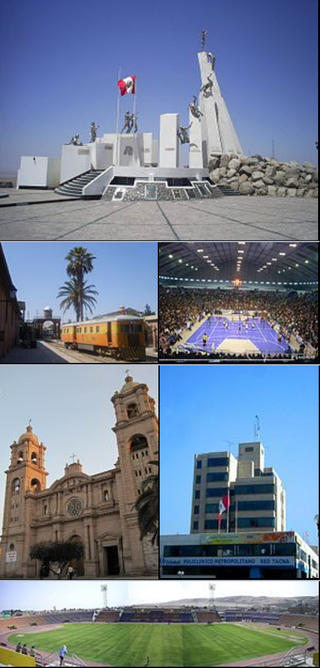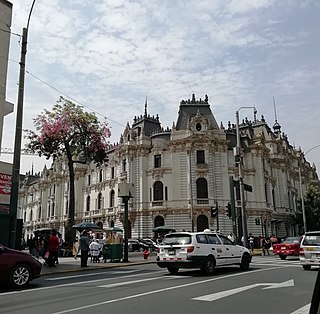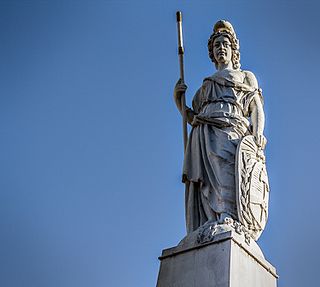
The Motherland (Spanish : Madre patria) is the national personification of Peru. [1] [2]

The Motherland (Spanish : Madre patria) is the national personification of Peru. [1] [2]
The figure, first introduced during the Peruvian War of Independence, [2] generally has the appearance of a (generally) seated female with a Greek profile wearing a laurel wreath and a white tunic. [1] Official usage included her appearance on banknotes and coins formerly issued by the Peruvian government, as well as in statues, such as the one in Flag Square or in the Plaza San Martín of central Lima. [3]

Tacna, officially known as San Pedro de Tacna, is a city in southern Peru and the regional capital of the Tacna Region. A very commercially active city, it is located only 35 km (22 mi) north of the border with Arica y Parinacota Region from Chile, inland from the Pacific Ocean and in the valley of the Caplina River. It is Peru's tenth most populous city.

The Government Palace, also known as the House of Pizarro, is the seat of the executive branch of the Peruvian government, and the official residence of the president of Peru. The palace is a stately government building, occupying the northern side of the Plaza Mayor in Peru's capital city, Lima. Set on the Rímac River, the palace occupies the site of a very large huaca that incorporated a shrine to Taulichusco, the last kuraka of Lima.

Lima is a district of Lima Province in Peru. Lima district is the oldest in Lima Province and as such, vestiges of the city's colonial era remain today in the historic centre of Lima, which was declared a UNESCO World Heritage Site in 1988 and contains the foundational area known as Cercado de Lima.

San Martín de Porres (SMP) is a district in Lima, Peru, located in the north area of the city. It is bordered by the Chillón River, marks its natural border with Ventanilla and Puente Piedra on the north; Callao on the west; Los Olivos, Comas on the northeast; Rímac and Independencia districts on the east; the Rímac River marks its natural border with Lima District and Carmen de la Legua Reynoso on the south. It is the second most populated district of Lima metropolitan area and Peru.

Located principally in the city centre or Cercado de Lima and Rímac areas, the Historic Centre of Lima is among the most important tourist destinations in Peru.
Independencia is a district of the Lima Province in Peru. It is located in the north area of the city.

Mariano Benlliure y Gil was a Spanish sculptor and medallist, who executed many public monuments and religious sculptures in Spain, working in a heroic realist style.

The Jirón de la Unión, or Union Street, is a pedestrian street located in the Historic Centre of Lima, part of the capital of Peru. For many decades it was the most important boulevards of the city, often described as the most aristocratic, where many of the most affluent citizens of the city and most powerful men around the world would meet. Subsequently, with the deterioration of the center of Lima, the Jirón de la Unión lost its aristocratic character and became completely commercialized.

The Plaza Mayor de Lima, or Plaza de Armas de Lima, is considered one of the birthplaces of the city of Lima, as well as the core of the city. Located in the Historic Centre of Lima, it is surrounded by the Government Palace, Lima Metropolitan Cathedral, Archbishop's Palace of Lima, the Municipal Palace, and the Palacio de la Unión.

The Plaza San Martín is one of the most representative public spaces of the city of Lima, Peru. It is located at the ninth block of Colmena avenue, within the Historic Centre of Lima which was declared a World Heritage Site in 1988 by UNESCO. It is located near the Plaza Mayor of Lima and is connected to it by the Jiron de la Union. Its central monument gives homage to Peru's liberator, José de San Martín.
There are many landmarks in Buenos Aires, Argentina some of which are of considerable historical or artistic interest.

There are various allegorical representations of Argentina or associated in any way with Argentina. There is not, however, a national personification with its own name, like Marianne from France, or Hispania from Spain, but sculptures and engravings representing liberty, republic, motherland or other concepts that have been used officially by the Argentine state.

José de San Martín is the national hero of Argentina, Chile and Peru, and along with Simón Bolívar, the most important Libertador of the Spanish American Wars of Independence. For this reason, he is homaged and depicted in several cultural works of those countries, and even internationally. He led the Campaign across the Andes from Argentina to Chile which has been studied around the world for its complexity.

The Plaza Bolognesi is a roundabout located in the Lima District and the Breña District, in the capital of Peru. It is located at the intersection of Brasil Avenue, Arica Avenue, Alfonso Ugarte Avenue, Guzmán Blanco Avenue, and 9 December Avenue.

The Monument to Manco Cápac is a statue located in the homonymous square in La Victoria District, Lima, the work of the Peruvian sculptor David Lozano, inaugurated in 1926.

Huaura is a city in Peru. It is the capital of the homonymous district located in the province of Huaura in the department of Lima. It had an estimated population of 24,668 according to the 2017 census. It ceased to be the provincial capital in 1866 in favor of the city of Huacho and is part of the conurbation formed around the latter by means of two bridges over the Huaura River.

Peru Square, formerly known as Pizarro Square, is a public square located in central Lima, Peru.

Italy Square, formerly known as Saint Anne's Square, is a public square in the Barrios Altos neighbourhood of Lima, Peru. It was the second square built by the Spanish during the colonial era and later served as one of the four squares where the independence of Peru was declared in the city.

The Flag Square is a public square in Lima, Peru. It is located next to the Mateo Salado Huaca at the intersection of Breña, Lima and Pueblo Libre districts.

The Plazoleta de la Merced, also known as the Plazuela de la Merced, is a public square located in front of the Basilica and Convent of Nuestra Señora de la Merced, at the fifth block of the Jirón de la Unión and its intersection with the Jirón Huancavelica, in the historic centre of Lima, Peru.